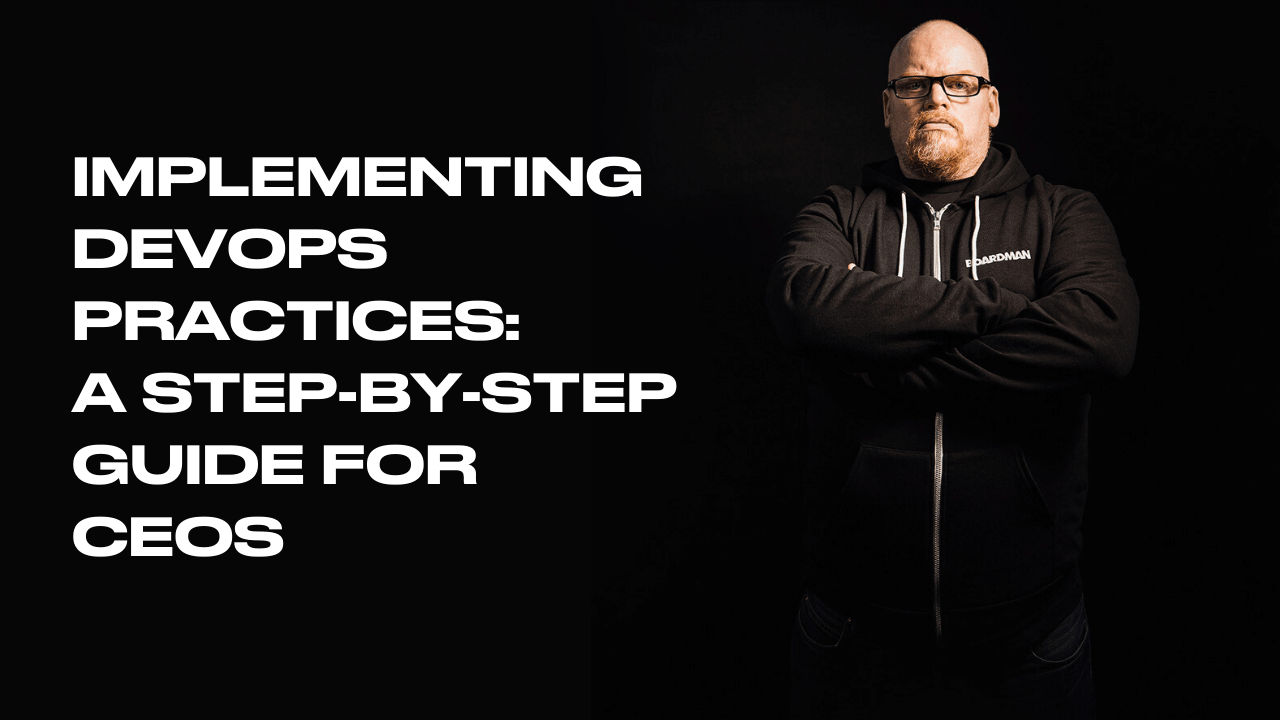
Implementing DevOps Practices: A Step-by-Step Guide for CEOs
Mar 08, 2024In the dynamic landscape of tech-driven scaling startups and SMEs, the importance of aligning technology with business objectives cannot be overstated. The lack of a permanent senior technology leader often results in misaligned strategies, resource misallocation, and stifled innovation. DevOps, a set of practices combining software development (Dev) and IT operations (Ops), offers a transformative solution. By fostering collaboration, automating processes, and ensuring continuous delivery, DevOps can significantly enhance productivity and strategic alignment.
Here’s a step-by-step guide for CEOs to implement DevOps practices effectively.
-
Understand the DevOps Philosophy
DevOps is not just a set of tools; it’s a cultural shift. It emphasises collaboration between development and operations teams, aiming to shorten the development lifecycle and deliver high-quality software continuously. This approach requires a change in mindset, where teams work together towards common goals rather than in silos.
Why it matters: In startups, where rapid growth and agility are paramount, adopting a DevOps culture can streamline processes, reduce time to market, and improve product quality.
-
Assess Your Current State
Before embarking on the DevOps journey, it’s crucial to understand your current processes, team structure, and technology stack.
Conduct a comprehensive assessment:
Process evaluation: Identify bottlenecks in your current development and deployment processes.
Team skills: Assess the skills of your team members and identify gaps.
Technology stack: Review your existing tools and infrastructure.
Why it matters: This assessment helps in identifying areas that need improvement and ensures that your DevOps strategy is tailored to your organisation’s specific needs.
-
Define Clear Objectives
Set clear, measurable objectives for your DevOps implementation. These could include:
- Reduced time to market
- Improved deployment frequency
- Enhanced product quality
- Increased collaboration between teams
Why it matters: Clear objectives provide direction and help in measuring the success of your DevOps initiatives.

-
Build a Collaborative Culture
Fostering a culture of collaboration is at the heart of DevOps. Encourage open communication and collaboration between development and operations teams.
Steps to build a collaborative culture:
Cross-functional teams: Form teams with members from both development and operations.
Regular meetings: Conduct regular stand-ups and retrospectives to ensure continuous feedback and improvement.
Shared responsibilities: Encourage teams to take ownership of both development and deployment processes.
Why it matters: A collaborative culture breaks down silos, ensures better communication, and leads to more efficient processes.
-
Implement Automation
Automation is a key component of DevOps, enabling faster and more reliable processes. Focus on automating repetitive and error-prone tasks.
Areas to automate:
Continuous Integration (CI): Automatically build and test code every time changes are made.
Continuous Deployment (CD): Automatically deploy code to production environments.
Infrastructure as Code (IaC): Manage and provision infrastructure through code rather than manual processes.
Why it matters: Automation reduces human error, speeds up processes, and allows teams to focus on more strategic tasks.
-
Choose the Right Tools
Selecting the right tools is essential for successful DevOps implementation. There are numerous tools available for different aspects of DevOps.
Categories of tools:
CI/CD tools: Jenkins, GitLab CI, CircleCI
Version control: Git, Bitbucket
Configuration management: Ansible, Puppet, Chef
Containerisation: Docker, Kubernetes
Monitoring and logging: Prometheus, ELK Stack (Elasticsearch, Logstash, Kibana)
Why it matters: The right tools enable automation, enhance collaboration, and ensure smoother DevOps processes.

-
Foster Continuous Learning and Improvement
DevOps is an ongoing journey of continuous improvement. Encourage a culture of learning and experimentation.
Promote continuous learning:
Training and workshops: Provide regular training sessions and workshops for your teams.
Experimentation: Encourage teams to experiment with new tools and practices.
Feedback loops: Implement feedback loops to learn from successes and failures.
Why it matters: Continuous learning ensures that your teams stay up-to-date with the latest practices and continuously improve processes.
-
Measure and Monitor Performance
To ensure the success of your DevOps initiatives, it’s crucial to measure and monitor performance continuously.
Key metrics to track:
Deployment frequency: How often you deploy new code to production.
Lead time: The time taken from code commit to deployment.
Mean time to recovery (MTTR): The time taken to recover from a failure.
Change failure rate: The percentage of changes that result in failures.
Why it matters: Monitoring these metrics helps in identifying areas of improvement and ensures that your DevOps practices are delivering the desired results.
-
Address Security Early
Integrating security into your DevOps practices, also known as DevSecOps, ensures that security is considered from the beginning rather than as an afterthought.
Steps to integrate security:
Shift-left testing: Incorporate security testing early in the development process.
Automated security checks: Use tools to automate security checks in your CI/CD pipeline.
Security training: Provide regular security training for your development and operations teams.
Why it matters: Integrating security early helps in identifying and addressing vulnerabilities sooner, reducing the risk of security breaches.
-
Scale and Adapt
As your organisation grows, your DevOps practices need to scale and adapt to new challenges. Continuously evaluate and adjust your processes, tools, and culture to ensure they meet your evolving needs.
Steps to scale and adapt:
Regular reviews: Conduct regular reviews of your DevOps practices to identify areas for improvement.
Scalable infrastructure: Invest in scalable infrastructure that can grow with your organisation.
Adapt to change: Be flexible and adapt to new tools, technologies, and practices as needed.
Why it matters: Scaling and adapting your DevOps practices ensures that they remain effective and continue to deliver value as your organisation grows.
Conclusion
Implementing DevOps practices is a transformative journey that requires a strategic approach, cultural shift, and continuous improvement. For CEOs of scaling startups and SMEs, embracing DevOps can lead to enhanced productivity, better alignment of technology with business goals, and a competitive edge in the market.
Remember, the success of DevOps lies not just in the tools you choose but in fostering a collaborative culture, automating processes, and continuously learning and adapting. By following this step-by-step guide, you can successfully implement DevOps practices in your organisation and drive sustained growth and innovation.

